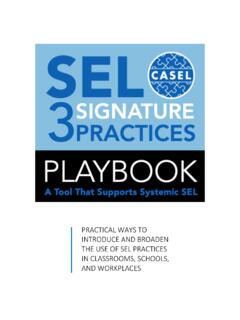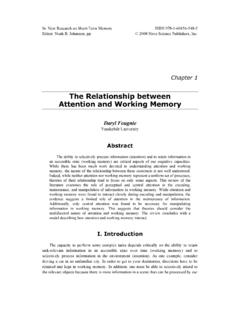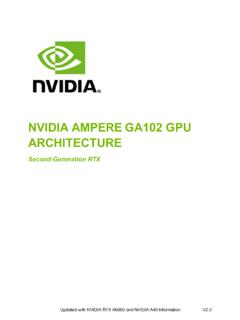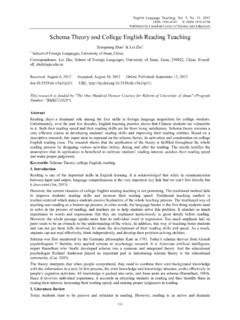Transcription of sCARF: a brain-based model for collaborating with and ...
1 ONe 2008 This article was published in theThe attached copy is furnished to the author for non-commercial research and education use, including for instruction at the author s institution, sharing with colleagues and providing to institutional administration. other uses, including reproduction and distribution, or selling or licensing copies, or posting to personal, institutional or third-party websites are most cases authors are permitted to post a version of the article to their personal website or institutional repository. Authors requiring further information regarding the neuroleadership journal s archiving and management policies are encouraged to send inquiries to: a brain - based model for collaborating with and influencing othersDavid rock1 NeuroLeadership institute 2008 For Permissions, email a brain - based model for collaborating with and influencing othersDavid rockCeo, Results Coaching systems international, GPo Box 395, sydney, NsW Australia 2001 Faculty, CiMBACo-founder, NeuroLeadership instituteeditor, NeuroLeadership a world of increasing interconnectedness and rapid change, there is a growing need to improve the way people work together.
2 Understanding the true drivers of human social behavior is becoming ever more urgent in this study of the brain , particularly within the field of social, cognitive and affective neuroscience is starting to provide some underlying brain insights that can be applied in the real world (Lieberman, 2007). social neuroscience explores the biological foundations of the way humans relate to each other and to themselves and covers diverse topics that have a different degree to which they can be operationalized and unambiguously tested. Topics include: theory of mind, the self, mindfulness, emotional regulation, attitudes, stereotyping, empathy, social pain, status, fairness, collaboration, connect-edness, persuasion, morality, compassion, deception, trust and goal this diversity, two themes are emerging from social neuroscience. Firstly, that much of our motivation driving social behavior is governed by an overarching organizing principle of minimizing threat and maximizing reward (Gordon, 2000).
3 Secondly, that several domains of social experience draw upon the same brain networks to maximize reward and minimize threat as the brain networks used for primary survival needs (Lieberman and eisenberger, 2008). in other words, social needs are treated in much the same way in the brain as the need for food and scarf model summarizes these two themes within a framework that captures the common factors that can activate a reward or threat response in social situations. This model can be applied (and tested) in any situation where people collaborate in groups, including all types of workplaces, educational environments, family settings and general social scarf model involves five domains of human social experience: status, Certainty, Autonomy, Relatedness and Fairness. status is about relative importance to others. Certainty concerns being able to predict the future. Autonomy provides a sense of control over events.
4 Relatedness is a sense of safety with others, of friend rather than foe. And fairness is a perception of fair exchanges between five domains activate either the primary reward or primary threat circuitry (and associated networks) of the brain . For example, a perceived threat to one s status activates similar brain networks to a threat to one s life. in the same way, a perceived increase in fairness activates the same reward circuitry as receiving a monetary reward. The model enables people to more easily remember, recognize, and potentially modify the core social domains that drive human behavior. Labelling and understanding these drivers draws conscious awareness to otherwise non conscious processes, which can help in two ways. Firstly, knowing the drivers that can cause a threat response enables people to design interactions to minimize threats. For example, knowing that a lack of autonomy activates a genuine threat response, a leader or educator may consciously avoid micromanaging their employees or students.
5 Secondly, knowing about the drivers that can activate a reward response enables people to motivate others more effectively by tapping into internal rewards, thereby reducing the reliance on external rewards such as money. For example, a line manager might grant more autonomy as a reward for good performance. research2 NeuroLeadership institute 2008 For Permissions, email researchBefore exploring the domains of scarf individually a brief context of the underlying science of the scarf model , Namely, the approach (reward)-avoid (threat) response and the impact of this response on mental performance, is of the scarf modelThe approach (reward)-avoid (threat) response: a survival instinctAccording to integrative Neuroscientist evian Gordon, the minimize danger and maximize reward principle is an overarching, organizing principle of the brain (Gordon, 2000). This central organizing principle of the brain is analogous to a concept that has appeared in the literature for a long time: the approach-avoid response.
6 This principle represents the likelihood that when a person encounters a stimulus their brain will either tag the stimulus as good and engage in the stimulus (approach), or their brain will tag the stimulus as bad and they will disengage from the stimulus (avoid). if a stimulus is associated with positive emotions or rewards, it will likely lead to an approach response; if it is associated with negative emotions or punishments, it will likely lead to an avoid response. The response is particularly strong when the stimulus is associated with survival. other concepts from the scientific literature are similar to approach and avoidance and are summarized in the chart approach-avoid response is a survival mechanism designed to help people stay alive by quickly and easily remembering what is good and bad in the environment. The brain encodes one type of memory for food that tasted disgusting in the past, and a different type of memory for food that was good to eat.
7 The amygdala, a small almond-shaped object that is part of the limbic system, plays a central role in remembering whether something should be approached or avoided. The amygdala (and its associated networks) are believed to activate proportionally to the strength of an emotional limbic system can processes stimuli before it reaches conscious awareness. one study showed that subliminally presented nonsense words that were similar to threatening words, were still categorized as possible threats by the amygdala (Naccache et al, 2005). Brainstem Limbic networks process threat and reward cues within a fifth of a second, providing you with ongoing nonconscious intuition of what is meaningful to you in every situation of your daily life (Gordon et al. Journal of integrative Neuroscience, sept 2008). such studies show that the approach-avoid response drives attention at a fundamental level nonconsciously, automatically and quickly.
8 It is a reflexive is easy to see that the ability to recognizing primary rewards and threats, such as good versus poisonous food, would be important to survival and thus a part of the brain . social neuroscience shows us that the brain uses similar circuitry for interacting with the social world. Lieberman and eisenberger explore this finding in detail in a paper in this journal entitled The Pains and Pleasures of social Life (Lieberman & eisenberger, 2008). The effects of approaching versus avoidingThe significance of the approach-avoid response becomes clearer when one discovers the dramatic effect that these states can have on perception and problem solving, and the implications of this effect on decision-making, stress-management, collaboration and one study, two groups of people completed a paper maze that featured a mouse in the middle trying to reach a picture on the outside.
9 One group had a picture of cheese on the outside, the other a predator an owl. After completing the maze both groups were given creativity tests. The group heading towards the cheese solved significantly more creative problems than those heading to the owl (Friedman and Foster, 2001). This study, supported by several other similar studies, shows that even subtle effects of this approach-avoid response can have a big impact on cognitive this effect to the social world, someone feeling threatened by a boss who is undermining their credibility is less likely to be able to solve complex problems and more likely to make mistakes. This reduced cognitive performance is responsesynonyms in literatureWhich traditional primary factors activate the responseWhat social factors/situations activate the responseapproachAdvance, attack, reward, resource, expand, solution, strength, construct, engage.
10 Rewards in form of money, food, water, sex, shelter, physical assets for , attractive faces. Rewards in the form of increasing status, certainty, autonomy, relatedness, , retreat, danger, threat, contract, problem, weakness, in the form of removal of money or other resources or threats like a large hungry predator or a , unattractive, unfamiliar faces. Threats in the form of decreasing status, certainty, autonomy, relatedness, NeuroLeadership institute 2008 For Permissions, email by several factors. Firstly, when a human being senses a threat, resources available for overall executive functions in the prefrontal cortex decrease. There is a strong negative correlation between the amount of threat activation, and the resources available for the prefrontal cortex (Arnsten, 1998). The result is literally less oxygen and glucose available for the brain functions involved in working memory , which impacts linear, conscious processing.







